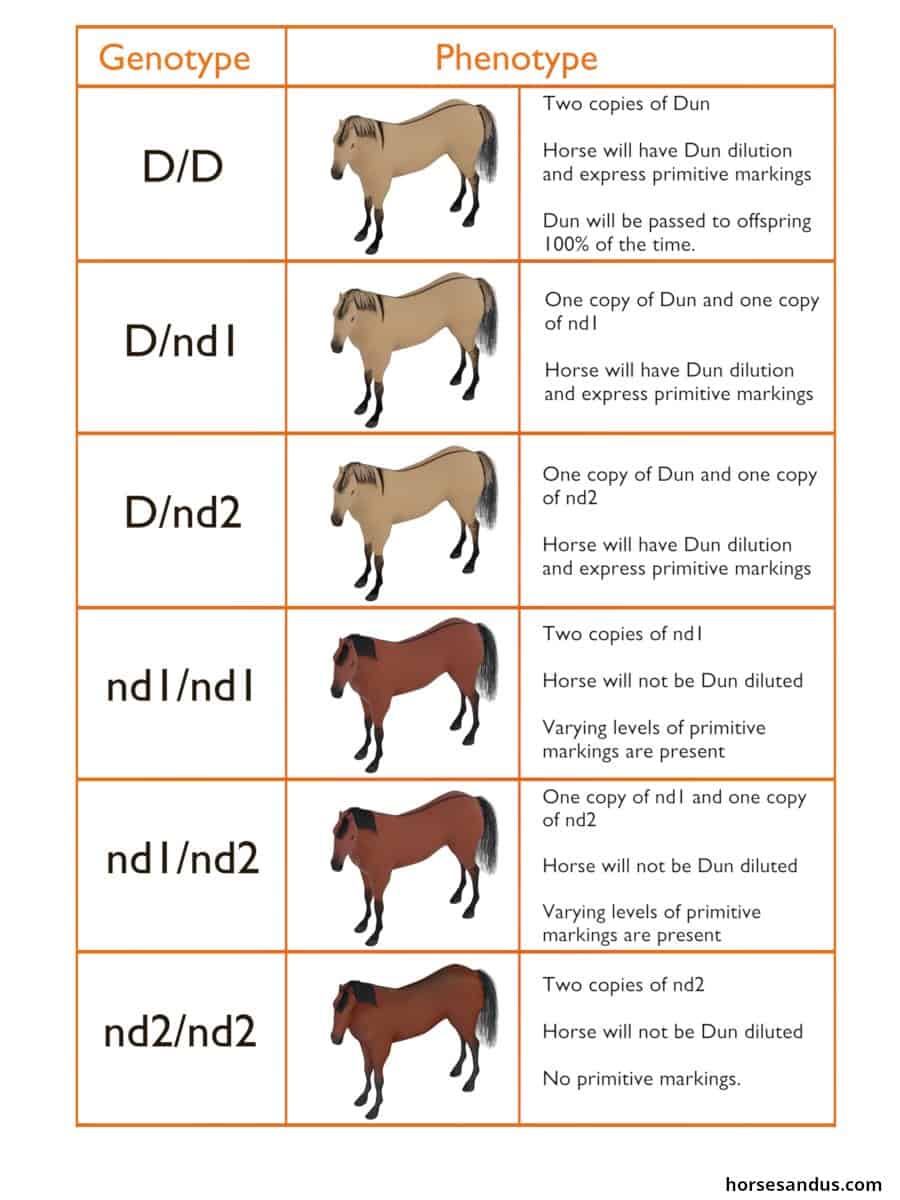Genetics
Heritability is the genetic phenomena of traits being passed down to offspring from previous generations. We call these traits the phenotype and the genetic code for the phenotype is called the genotype. There is an ongoing discussion about how heritability is related to nature vs. nurture, and how they are supported by everything we know about genetics today. Heritability by nurture suggests that an individual’s traits can be influenced by environmental factors while heritability by nature focuses on how heritability is influenced by genetic information passed though the genotype. A scale ranging from 0 to 1 can be used to measure the heritability of a trait. 0 represents a trait inherited by nurture and 1 represents a trait inherited through nature. The case shared today is an example of the latter and how heritability is a result of genetic material shared through genotypes.
Dun is a coat color in horses characterized by a dilution of the base coat color. This dilution, the genetic cause is explained later, results in a lighter colored coat but the head/face, lower legs, mane, and tail remain undiluted. The dun color is often distinguished by a dorsal stripe and can be accompanied by other primitive markings such as zebra stripes or barring on the legs, black rims on the ears, webbing and lacing along the withers and back. The Dun phenotype can be found in many horse breeds but is more prevalent among American Quarter Horses or wild horse breeds such as Przewalskis and Spanish Mustangs like the Sulphur Springs Mustangs.
The Dun gene is expressed through autosomal dominance and is represented with these alleles: D = Dun dilute, nd1 = non-dun 1, and nd2 = non-dun 2. An explanation of genotypes is as follows below:

- D/D – this horse will have the dun dilute and will pass the dominant dun phenotype to all offspring.
- D/nd1 or D/nd2 – this horse will have the dun dilute and will also display primitive markings. The dun dilute may be passed on to 50% of their offspring.
- nd1/nd1 – this horse will not have the dun dilute but may or may not display primitive markings. The non-dun 1 variant will be passed on to all their offspring.
- nd1/nd2 – this horse will not have the dun dilute but may or may not display primitive markings. The non-dun 1 variant may be passed to 50% of the offspring.
- nd2/nd2 – this horse will not have the dun dilute and will not have primitive markings. The dun dilution variant cannot be passed to their offspring. For more information on the dun gene alleles click here.
The dun dilute with the presence of primitive markings is considered the wild-type. The pigment dilution in Dun horses is due to radially asymmetric deposition of pigment in the growing hair caused by localized expression of the T-box 3 (TBX3) transcription factor in hair follicles, which in turn determines the distribution of hair follicle melanocytes. There are two forms of dark, non-dun color: non-dun1 and non-dun2, which are caused by different mutations. Non-dun1 horses differ from dun horses in that they have a darker coat and less contrast between the stripes and the rest of the body. On the other hand, non-dun2 horses show no stripes at all. To learn more about the TBX3 transcription factor click here. Non-dun horses have a much more vibrant color than dun horses. Non-dun1 horses tend to show primitive markings similar to dun horses, whereas non-dun2 horses generally don’t show primitive markings. These primitive markings in non-dun1 horses can sometimes lead horse owners to think that their intensely pigmented non-dun1 horses are dun. Most domestic horses are non-dun, and this intensely pigmented phenotype is caused by regulatory mutations impairing TBX3 expression in the hair follicle, resulting in a more circumferential distribution of melanocytes and pigment granules in individual hairs. For more information about TBX3 and the dun gene click here.

An illustration of the mechanism underlying dun color. TBX3 expression (green) in the hair follicle of dun horses leads to lack of pigment production in parts of the hair follicle (pigment indicated in black). In non-dun horses, there is no TBX3 expression in the hair follicle, and the entire hair is fully pigmented. – Drawing by Kelly McGowan and Freyja Imsland – To learn more about this illustration click here.
The dun gene can dilute both red (chestnut base coat) and black (black base coat) pigment yielding the variation of dun horses. “E” is usually used for the black coat color allele in horses, such that “EE” represents a black horse and “ee” represents a chestnut (red) horse. A dun horse with a base coat color of chestnut would be called a red dun and if that horse has a flaxen mane and tail, they are called a claybank dun. Red duns can vary in color from extremely dark red to a very light tan/red color. This horse would have a dun allele such as “D” diluting the chestnut base coat allele “ee.” A dun horse with a base coat color of black would be called a grulla dun but people also refer to them as blue duns, black duns, grey duns or mouse duns. This horse would have a dun allele such as “D” diluting the black base coat allele “EE.” Click here to learn more about different dun colors.
The genetic phenomenon that describes two genes interacting and influencing a phenotype is called epistasis. The dun dilution gene in horses is an example of epistasis because the dun dilution gene influences the expression of the coat color gene in horses.
The dun gene in horses is an example of nature and how heritability is a result of genetic material shared through genotypes. The TBX3 transcription factor in hair follicles determines the distribution of hair follicle melanocytes that result in the differences between the D, nd1, and nd2 alleles that make up the dun gene.